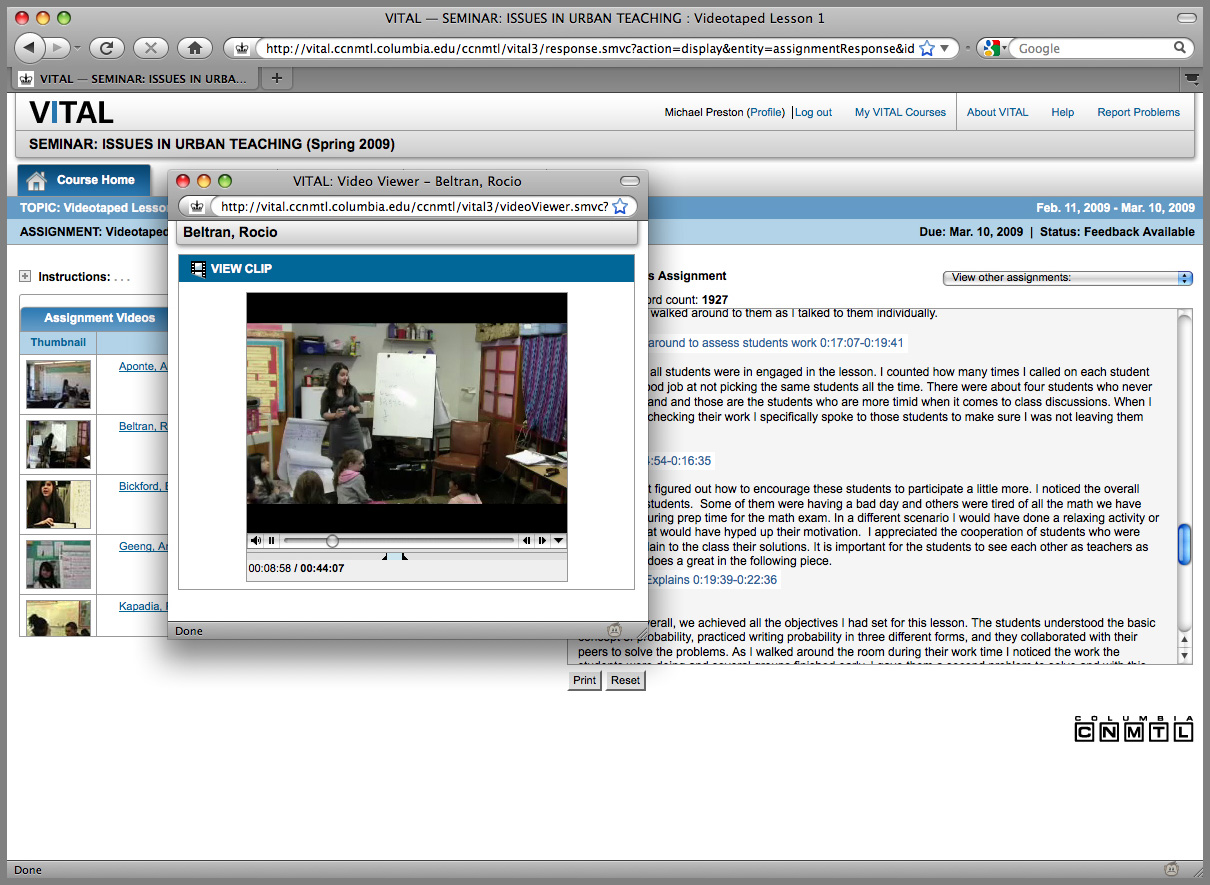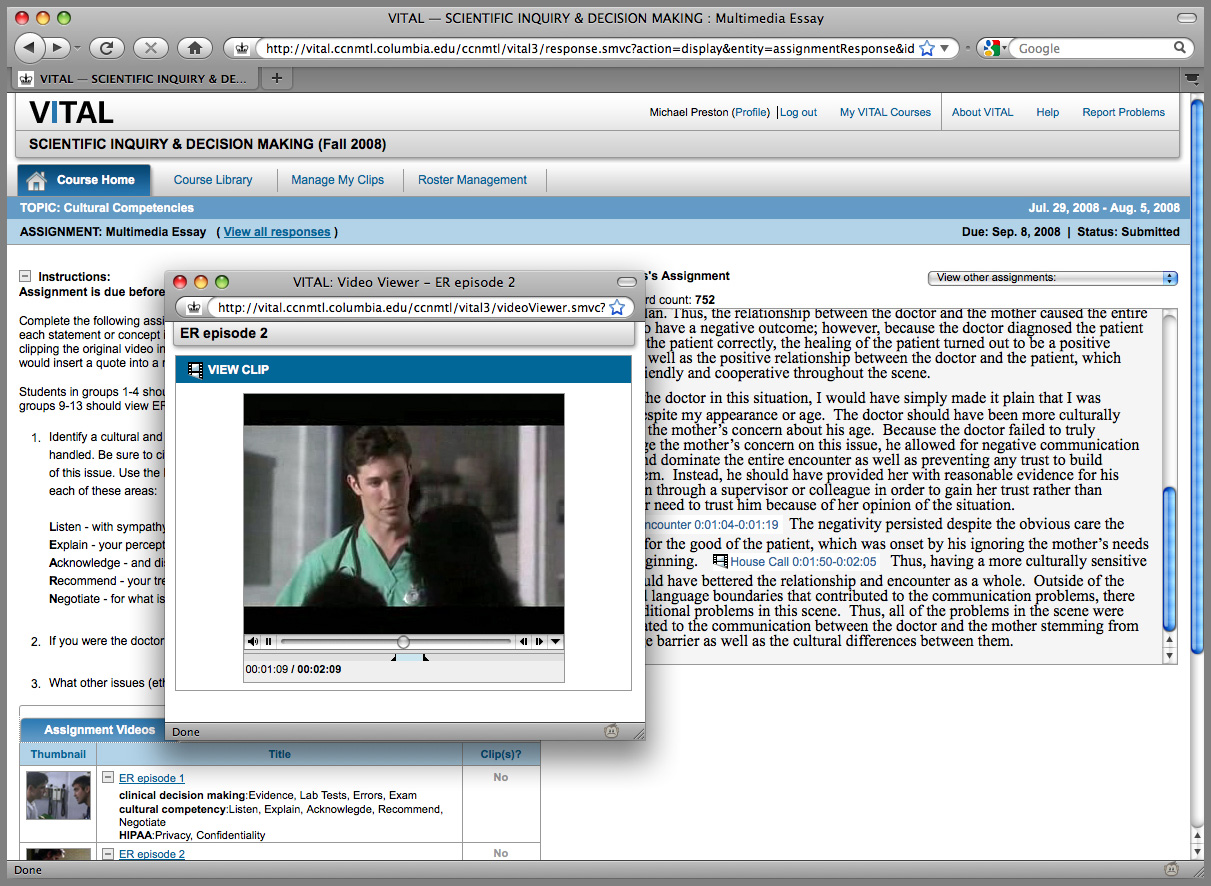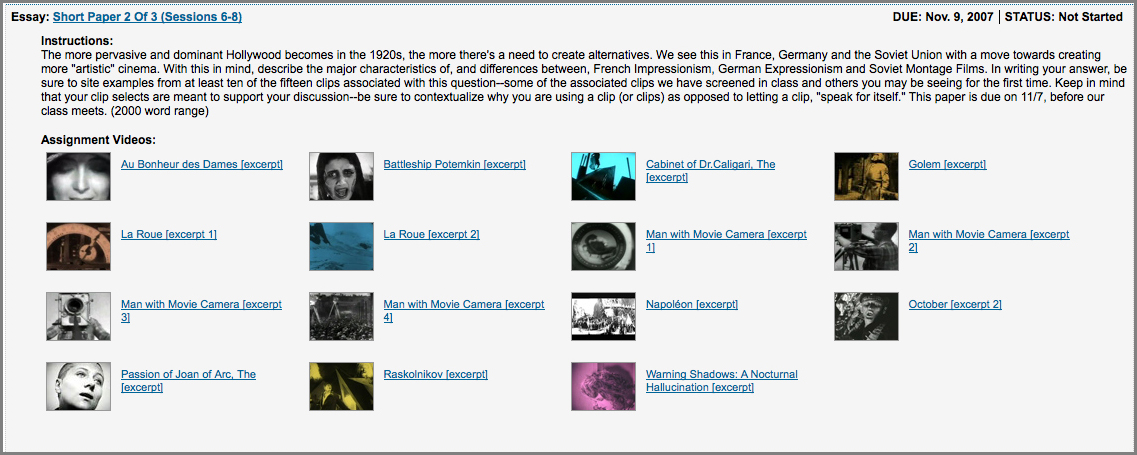"VITAL mobilizes the power of digital technologies and media to provide students and faculty not only with access to the primary sources of video case studies, but to an online work environment that permits study, analysis, and student knowledge production."
--Frank Moretti, Executive Director, CCNMTL
 | ||
- Analyze footage of classroom teaching
- Develop classroom assessment skills
- Critique therapeutic techniques or methodologies
- Learn about cultural competency
- Analyzing film medium
- Develop a coding scheme for behavior
- Review role-play scenarios
To help illustrate how faculty integrate VITAL into their teaching, CCNMTL has documented a series of use cases from the disciplines in which VITAL is most actively used: Teacher Education, Clinical Practice, and the Arts.
![]()
I. Teacher Education
At Teachers College and Barnard College, students in education seminars use VITAL to analyze footage of their own classroom teaching and share their commentaries with instructors to develop skills of self-reflection and assessment. Students in developmental psychology and music education at Teachers College learn to assess young children's verbal and nonverbal behaviors.
Seminar: Issues in Urban Teaching - Professor Lee Anne Bell, Barnard College
 | ||
Pedagogical approach: Undergraduate students in the Barnard education program take an education seminar in conjunction with their student teaching. The seminar is a small class that meets weekly to discuss curriculum, pedagogy, assessment, and other topics. More important, it provides students with an opportunity to discuss their experiences in the classroom. VITAL has become an integral part of the seminar because it enables students to videotape their own lessons, upload them to VITAL, and use their videos for reflection and sharing with Professor Bell and their peers.
Implementation: Students videotape themselves twice during the semester. Once their videos have been added to VITAL, students can view them as often as they like, and using the VITAL editing tools, they can select the significant moments on which they wish to reflect. The students use these selections to critique their teaching performance according to a rubric provided by Professor Bell, including physical and verbal habits, student engagement, student understanding, behavior management, and other criteria. Student "publish" their reflections in VITAL to be read by Professor Bell and the class. In addition to formal feedback written by Professor Bell in VITAL, students can discuss their teaching experiences in person when they meet as a seminar, and the VITAL video archive provides a common reference to which they can refer. Students then use what they have learned to plan for their next videotaped lesson.
The Development of Mathematical Thinking - Professor Herbert Ginsburg, Teachers College
 | ||
Pedagogical approach: Professor Ginsburg uses VITAL primarily in his course on early childhood mathematics education, which is based on theories of developmental psychology as well as teaching and assessment practices derived from research. Professor Ginsburg collaborated with CCNMTL to develop VITAL, which was originally conceived as a method to enable his students to practice the kind of close viewing and analysis of video he models in class. It also forces them to prepare better for class by completing integrative assignments (readings + videos), so they are ready to discuss and debate their interpretations.
Implementation: Students are required to complete one assignment before lecture in each of the first 10 weeks of the course. Assignments are either essays of approximately 350 words in length or "guided lessons" on clinical interviewing. Students also complete a weekly reflection on what they learned. The final project for the course is an extended essay in VITAL. Students must first videotape themselves doing a teaching activity with and interviewing a child to assess learning. Then, in VITAL, they must write an analysis of the activity and of their assessment, using their video to provide supporting evidence. Herb can subsequently assess his students' mastery of the theoretical content, their teaching and interviewing skills, and their interpretation of the video itself.
![]()
II. Clinical Training
At the Columbia University School of Social Work, students watch examples of professional therapists as well as their peers' role-plays, and use VITAL to relate theories to practice and to critique the therapists' methods. At the College of Dental Medicine, students are introduced to cultural competency by analyzing cases involving sensitive issues.
Advanced Clinical Practice - Various Faculty Members, School of Social Work
 | ||
Pedagogical approach: At the Columbia University School of Social Work, second year students take "Advanced Clinical Practice" courses that emphasizes assessment, intervention, and evaluation, and focuses on individual, family, group, and case management strategies; clinical application of risk and resiliency theories and research to at-risk populations; and clinical issues with specific client populations. Students in Advanced Clinical Practice courses use VITAL to connect class readings to professionally produced recordings of clinical sessions with couples.
Implementation: One of the goals of the use of VITAL in this course was to improve students' evidence-based reasoning, a crucial aspect of effective social work practice. By viewing the videos, clipping and annotating segments, and adding those video annotations to assigned essays, students identify and analyze different theoretical models and clinical techniques as well as consider their own intervention methods. The multimedia essay assignments encourage closer readings of clinician/patient interactions. Sharing completed multimedia essays with other social work students fosters group discussion and learning from peers, both important aspects of social work education.
Scientific Inquiry & Decision Making - Professor John Zimmerman, College of Dental Medicine
 | ||
Pedagogical approach: At the College of Dental Medicine, students are introduced to cultural competency by analyzing cases involving sensitive issues. The VITAL application gives these students the opportunity to critically assess doctor/patient interactions and to apply the fundamentals of cultural competency to this interaction. For each statement or concept in the essay, students are asked to cite video evidence to support their answer.
Implementation: This is a required assignment in the course and after the students complete their essays we review major finding in the class (75 students). The students are asked to identify a cultural issue in this scene and describe how it was handled. They must cite both positive and negative aspects of the doctor/patient interaction of this issue, and use the LEARNING mnemonic as a guide:
- Listen to person's explanation of what's wrong and what caused it.
- Explain what you think may have caused the problem.
- Acknowledge areas of agreement and differences.
- Recommend your treatment or course of action.
- Negotiate for what is most important.
- Involve person in the interaction.
- Never negate other person's beliefs or views.
- Gather the family or decision makers when ever necessary.
![]()
III. The Arts
At the Columbia University School of the Arts, students in the Film Division learn about avant garde and silent cinema, using VITAL to create collections of footage based on themes they study across films and periods. Students in a course on the history and theory of dance study choreography, original sources, and critical methodologies associated with 20th century dance.
Silent Cinema - Professor John Frankfurt, School of the Arts
 | ||
Pedagogical approach: VITAL is used in this class to address three principal questions: How have uses of the film medium changed or become normalized over time? How have the conditions of film history--production, distribution, and exhibition--affected the uses of the medium? And finally, how have international trends in the uses of the film medium and in the film market changed? The clips the students make in VITAL should support both the cinematic and extra-cinematic factors they are addressing. This is an important point as the close analysis of the clips in VITAL should not be done in isolation of the larger questions of the course.
Implementation: Students began with two practice assignments in VITAL: (1) a non-graded essay that focused on the activity of clipping and embedding clips, and (2) reading a sample VITAL essay written by the instructor. They completed two essays in VITAL during the semester: the first asked them discuss the major points one needs to consider in the move from non-narrative to narrative film from 1894 to 1911, and the second asked them to identify the major characteristics of, and differences between, French Impressionism, German Expressionism, and Soviet Montage Films.
History of Modern Dance - Professor Mark Franko, School of the Arts
 | ||
Pedagogical approach: The History and Theory of Dance course is a survey of twentieth-century theatrical dance and an introduction to the critical methodologies currently used in Dance Studies. Expressions of subjectivity, gender, race, ethnicity and class are analyzed from within the aesthetic practices of historically and culturally contextualized movement and choreography. One of the primary take away for students in the class is to acquire a general knowledge of choreography, primary sources, and critical sources as well as an introduction to the interdisciplinary methodological tools of Dance Studies. Similarly, students are expected to identify and analyze the various consistencies and trans-tendencies of dance movements as seen through developing styles and various reconstructions within performances.
Implementation: The final paper assigned to the class was written in VITAL. The focus of the paper was to analyze when dances appear to rewrite earlier dances in whole or in part as a phenomenon of quotation, intertextuality, or choreographic sourcing. Students were required to clip segments of dance performances to quote them in their papers, thus illustrating and/or providing evidence for how these quotations or allusions in performances become choreographic material in their own right when placed in a new context. In addition, students were asked use the notion of citation to develop ideas about the specific work that engages in quotation. What effects are obtained by citation, and how do they contribute to the dance's meaning? Ultimately, the use the quotation process as part of the research was a way to define the parameters of choreographic citation itself.

